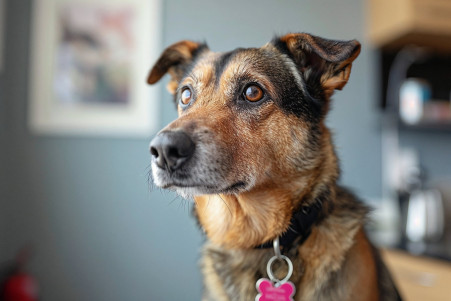Do Dogs Get Skin Tags? What to Know About Skin Tags in Dogs
4 February 2024

If you’ve ever had a skin tag, you know how annoying they can be. But did you know that dogs can get skin tags too? Skin tags are small, benign, non-cancerous growths that often appear on the chest, legs, and neck. They are more common in older dogs and certain breeds, and while they are typically harmless, they can be removed by a vet if they become irritated or bothersome.
This article will cover a range of research from veterinary medicine and dermatology to help you better understand how common skin tags are in dogs, what causes them, and how they can be treated. By drawing on information from academic research, clinical case reports, and expert veterinary opinions, we aim to provide a thorough overview of this common skin condition in dogs.
Can dogs get skin tags?
Understanding Dog Skin Tags: Signs and Characteristics
Skin tags, also known as acrochordons or fibrovascular papillomas, are benign growths that appear as small, stalk-like protrusions on a dog’s skin. According to MetLife Pet Insurance, these growths, which are also called hamartomas, can look different but are often described as looking like warts or raisins and are most often found growing out of or near hair follicles.
They are more common in larger dogs, like German Shepherds, and certain types, such as collagenous nevi or fibromas, are more common in older dogs.
As The Spruce Pets describes, these skin tags are made up of collagen and blood vessels and can appear as flaps or bumps that contain hair and can become irritated if they grow too large or are in an area where they are constantly rubbed.
Because they can look so different, from skin-colored to darker, and come in different shapes and sizes, it’s important to be able to identify them so you can tell them apart from other skin conditions or external parasites like ticks.
To recognize skin tags, pet parents should look for soft, raised bumps or pedunculated growths. It’s also important to keep an eye on them for any changes in color, size, or shape, as these could be signs that they need to be checked out by a vet, according to Wag Walking.
By keeping a close eye on your dog’s skin and checking it regularly, you can help ensure that you catch and manage skin tags early.
Digging Deeper: Why Do Dogs Get Skin Tags?
Skin tags in dogs, also known as fibrovascular papillomas or hamartomas, arise with no single cause. That said, Purina points to chronic irritation and friction as potential causes, especially in areas where a dog’s skin is constantly rubbing against itself or other surfaces, like skin folds and under collars.
MetLife Pet Insurance goes into more detail about genetic predispositions, explaining that certain breeds, like Boxers, English Bulldogs, and Cocker Spaniels, are more prone to these non-cancerous growths.
While the genetic link is not well understood, it seems to be tied to environmental factors like sun exposure. Age is another important factor, as skin tags are more common in middle-aged and older dogs. Research on specific types of skin tags, like collagenous hamartomas, backs up their prevalence in older dogs.
Purina recommends preventive measures that involve keeping skin folds clean, providing supportive bedding, and ensuring that collars fit properly to avoid unnecessary irritation. While these steps may not prevent skin tags altogether, they can help lower the risk and improve overall skin health. Regular vet visits can also help ensure that skin growths are caught early and monitored, so that they can be treated properly and promptly.
Understanding the Risk: Can Skin Tags Be Dangerous for Dogs?
The good news for dog owners is that skin tags are generally harmless and do not pose a direct risk to a dog’s health. As Vetster notes, these growths are usually non-cancerous and won’t cause any issues for a dog unless they’re in a place where they can be easily injured or infected.
That said, if a skin tag is scratched or caught on something, especially if it’s injured, it can become irritated, infected, or even bleed.
It’s important to keep an eye on skin tags. Vetster warns that you should look for any changes in the size, color, or shape of a growth, as these could be signs of more serious issues, like skin cancer. Canine Journal also cautions that while skin tags are usually nothing to worry about, any that are causing a dog discomfort or that have changed significantly should be checked out by a vet.
If a skin tag becomes irritated, infected, or changes quickly, it’s important to get the dog to the vet right away. In these cases, the skin tag may need to be removed to ensure the dog’s comfort and health. By keeping an eye on your dog’s skin and getting in touch with your vet if you notice anything unusual, you can help make sure that your dog stays healthy.
How to Get Your Dog Diagnosed and Treated for Skin Tags
Diagnosing skin tags in dogs will typically start with a physical exam by a veterinarian. During the exam, the vet will look at the growth’s size, shape, and location to determine if it’s a benign skin tag, according to Animal Trust. Sometimes, a biopsy may be needed to rule out cancer or another skin condition.
There are a few different ways to treat skin tags, but if the skin tag is causing discomfort or is at risk of being injured, the vet will likely remove it surgically. The vet may also use cryosurgery, which involves freezing the skin tag off, or they may decide to leave the skin tag alone if it’s not causing any problems, says Hill’s Pet.
The decision to treat or not will depend on the skin tag’s size, location, and how it’s affecting the dog’s quality of life.
After treatment, it’s important to make sure the dog doesn’t get an infection and that the skin tag heals properly. The vet will likely recommend keeping the area clean, watching for signs of infection, and scheduling follow-up appointments to make sure the dog is healing as expected. With the right care and attention, dogs can live comfortably and happily with skin tags.
Preventative Measures for Your Dog’s Skin Health
Preventing skin tags in dogs requires a multi-pronged approach, the first of which is regular skin checks. Merck Veterinary Manual encourages pet parents to be proactive in checking for any new skin tags or changes in existing ones, and even suggests taking pictures to track any changes that may occur. Regularly checking your dog’s skin can help catch skin tags early and other skin issues that may need to be addressed by a vet.
VCA Animal Hospitals also notes that a dog’s diet is important for maintaining healthy skin and coat. A diet that includes omega-3 fatty acids, vitamins, and minerals, especially zinc, can help improve the shine of a dog’s coat and reduce dry skin.
In addition, grooming is about more than just keeping your dog looking good, it’s also important for long-term care. The American Kennel Club encourages pet parents to maintain a regular grooming schedule that can help catch skin issues early and keep their dog’s skin healthy overall.
By following these preventative measures and making thoughtful changes to your dog’s lifestyle and environment, you can make a big difference in your dog’s skin health. In doing so, you’ll help ensure that your pet is comfortable and healthy as they age, setting them up for a successful transition into their senior years.
In Conclusion: What We’ve Learned About Skin Tags in Dogs
Throughout this article, we’ve delved into the details of skin tags in dogs and found that, like humans, dogs are susceptible to these non-cancerous skin growths. While skin tags in dogs are generally harmless, they are most likely to occur in old age and are more common in certain breeds.
We’ve also discussed how to tell skin tags apart from other skin issues and why it’s important to keep an eye out for any changes that could indicate a need to see a vet.
Our look into the causes of skin tags has shown that genetics, friction, and environmental factors all play a role, but none of these things are likely to be an immediate threat to our pets. That said, it’s important to be aware. We recommend that dog owners keep up with regular vet visits so that any skin issues can be evaluated by a professional.
In summary, part of being a good pet parent is taking care of our dogs’ health, and that includes dealing with skin tags. By being aware, keeping up with regular skin checks, and creating a supportive environment, we can make sure that we’re doing everything we can to help our dogs live their best lives in comfort and happiness.


